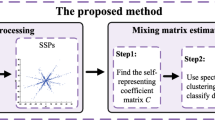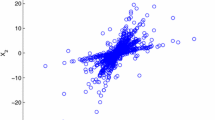Abstract
In this paper, a method of mixing matrix estimation based on time-frequency single source points detection and eigenvalue decomposition is proposed under the underdetermined blind source separation model. Firstly, short-time Fourier transform is used to transform non-sparse observed signals in time domain to sparse signals in time-frequency domain, and SSPs detection is employed to improve the sparsity. Secondly, the improved fuzzy C-means clustering algorithm is applied to estimate the number of sources. Then, we reselect the SSPs by the means of ordinary least squares to improve the estimation accuracy. Finally, the estimated mixing matrix is obtained by eigenvalue decomposition. Vast simulations illustrate that our method can estimate the mixing matrix accurately when the number of sources is unknown, and has strong robustness to noise.










Similar content being viewed by others
References
Abolghasemi, V., Ferdowsi, S., Sanei, S.: Fast and incoherent dictionary learning algorithms with application to FMRI. Signal Image Video Process. 9(1), 147–158 (2015)
Pedersen, M.S., Wang, D., Larsen, J., Kjems, U.: Two-microphone separation of speech mixtures. IEEE Trans. Neural Netw. 19(3), 475–92 (2008)
Hattay, J., Belaid, S., Lebrun, D., Naanaa, W.: Digital in-line particle holography: twin-image suppression using sparse blind source separation. SIViP 9(8), 1767–1774 (2015)
Yu, Y., Petropulu, A.P.: Parafac-based blind estimation of possibly underdetermined convolutive MIMO systems. IEEE Trans. Signal Process. 56(1), 111–124 (2008)
Bofill, P., Zibulevsky, M.: Underdetermined blind source separation using sparse representations. Signal Process. 81(11), 2353–2362 (2001)
Cichocki, A., Phan, A.H., Caiafa, C.: Flexible Hals algorithms for sparse non-negative matrix/tensor factorization. In: 2008 IEEE Workshop on Machine Learning for Signal Processing; Cancun, Mexico, Cancun, Mexico, pp. 73–78 (2008)
De Lathauwer, L., Castaing, J.: Blind identification of underdetermined mixtures by simultaneous matrix diagonalization. IEEE Trans. Signal Process. 56(3), 1096–1105 (2008)
Georgiev, P., Theis, F., Cichocki, A.: Sparse component analysis and blind source separation of underdetermined mixtures. IEEE Trans. Neural Netw. 16(4), 992–996 (2005)
Naini, F.M., Mohimani, G.H., Babaie-Zadeh, M., Jutten, C.: Estimating the mixing matrix in sparse component analysis (SCA) based on partial k-dimensional subspace clustering. Neurocomputing 71(10–12), 2330–2343 (2008)
Fu, W., Zhou, X., Nong, B., Li, C., Liu, J.: Blind estimation of underdetermined mixing matrix based on density measurement. Wireless Pers. Commun. 104(4), 1283–1300 (2019)
Zhen, L., Peng, D., Yi, Z., Xiang, Y., Chen, P.: Underdetermined blind source separation using sparse coding. IEEE Trans. Neural Netw. Learn. Syst. 28(12), 3102–3108 (2017)
Jourjine, A., Rickard, S., Yilmaz, O.: Blind separation of disjoint orthogonal signals: demixing n sources from 2 mixtures. In: Proceedings of 2000 IEEE International Conference on Acoustics, Speech, and Signal Processing, 2000. ICASSP ’00, vol. 5, pp. 2985–2988 (2000)
Abrard, F., Deville, Y.: A time-frequency blind signal separation method applicable to underdetermined mixtures of dependent sources. Signal Process. 85(7), 1389–1403 (2005)
Li, Y., Amari, S.I., Cichocki, A., Ho, D., Xie, S.: Underdetermined blind source separation based on sparse representation. IEEE Trans. Signal Process. 54(2), 423–437 (2006)
Reju, V.G., Soo, N.K., Soon, I.Y.: An algorithm for mixing matrix estimation in instantaneous blind source separation. Signal Process. 89(9), 1762–1773 (2009)
Sun, J., Li, Y., Wen, J., Yan, S.: Novel mixing matrix estimation approach in underdetermined blind source separation. Neurocomputing, 173(Jan.15 Pt.3):623–632 (2016)
Li, Y., Wang, Y., Dong, Q.: A novel mixing matrix estimation algorithm in instantaneous underdetermined blind source separation. SIViP 14(11), 1001–1008 (2020)
Guo, Q., Ruan, G., Liao, Y.: A time-frequency domain underdetermined blind source separation algorithm for MIMO radar signals. Symmetry 9(7), 104 (2017)
Bliss, D.W., Forsythe, K.W.: Multiple-input multiple-output (MIMO) radar and imaging: degrees of freedom and resolution. In: 37th Asilomar Conference on Signals. Systems and amp; Computers, Pacific Grove, California, USA, , vol. 1, pp. 54–59 (2003)
Liu, Z., Li, L., Zheng, Z.: Mixing matrix estimation method for dual channel time-frequency overlapped signals based on interval probability. ETRI J. 41(5), 658–669 (2019)
Treerattanapitak, K.: Outlier detection with possibilistic exponential fuzzy clustering. In: Eighth International Conference on Fuzzy Systems and Knowledge Discovery, pp. 456–460, Shanghai (2011)
Author information
Authors and Affiliations
Corresponding author
Additional information
Publisher's Note
Springer Nature remains neutral with regard to jurisdictional claims in published maps and institutional affiliations.
Appendix
Rights and permissions
About this article
Cite this article
Bai, P., Yang, Y., Xue, F. et al. Underdetermined mixing matrix estimation based on time-frequency single source points detection and eigenvalue decomposition. SIViP 16, 1061–1069 (2022). https://doi.org/10.1007/s11760-021-02055-5
Received:
Revised:
Accepted:
Published:
Issue Date:
DOI: https://doi.org/10.1007/s11760-021-02055-5




